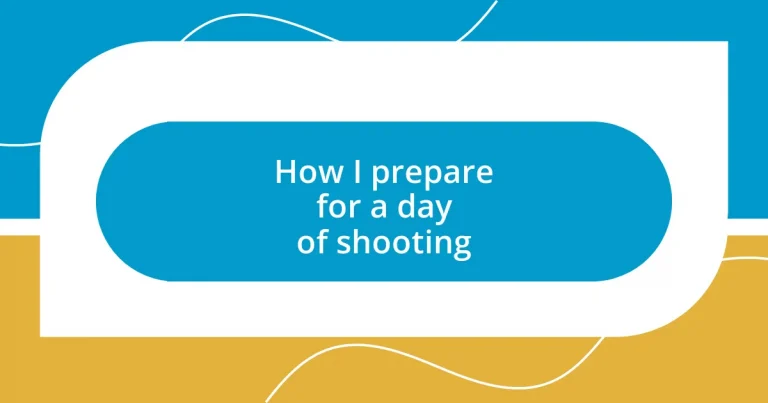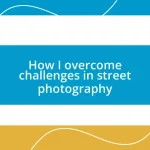Key takeaways:
- Effective shooting schedules should include specific time slots, buffer time for adjustments, and consideration of lighting conditions.
- Selecting the right gear is crucial; versatility in equipment and backup options can prevent unexpected issues during shoots.
- Mental preparation through mindfulness techniques, such as meditation and positive affirmations, enhances creativity and focus on shooting days.
- Consistently reviewing a detailed checklist prior to shooting prevents forgetfulness and reduces pre-shoot anxiety, ensuring a smooth workflow.
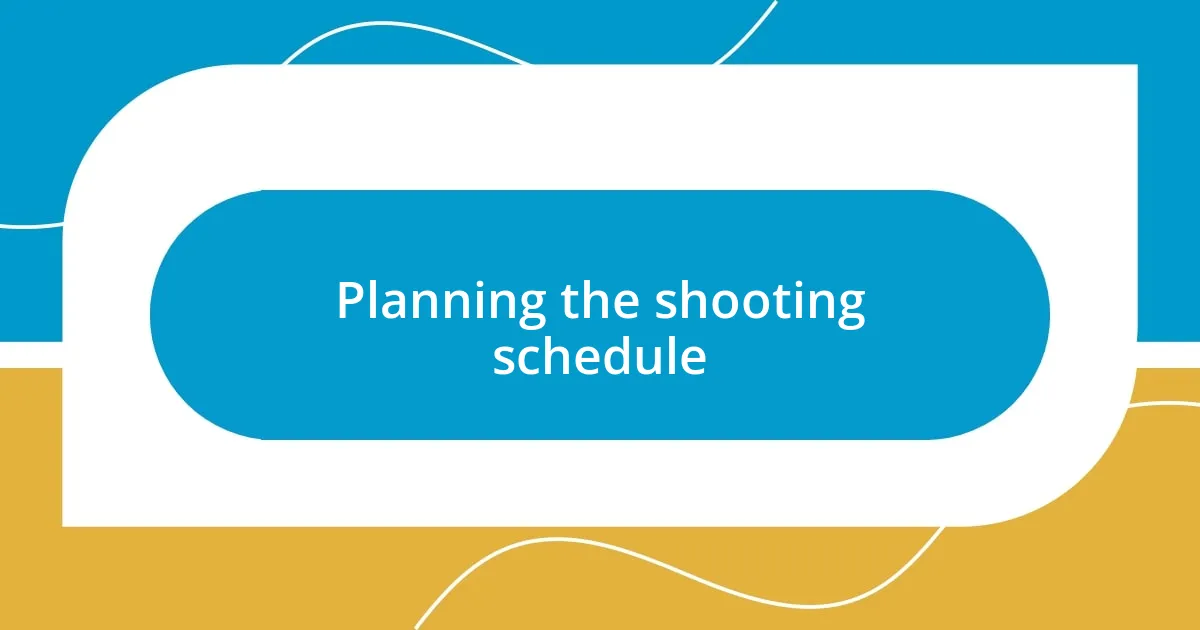
Planning the shooting schedule
When I plan my shooting schedule, I find it essential to block out specific time slots for each scene or segment. This isn’t just about minimizing chaos; it creates a flow that keeps the entire crew engaged and focused. Have you ever noticed how a well-timed shoot can lift the energy? It’s like orchestrating a symphony where each note contributes to the larger composition.
I always consider the lighting conditions and how they change throughout the day. For example, one time I set an early morning scene for a short film, and the soft, golden light made all the difference. Those moments remind me that nature can be our best ally if we learn to work within its rhythms.
Don’t forget to leave buffer time between scenes! I can’t tell you how many times I’ve been saved by a little extra time to adjust equipment or catch our breath. It’s those unexpected delays that can lead to the most creative breakthroughs. When have you found that a little flexibility in your schedule opened new doors for you, too?
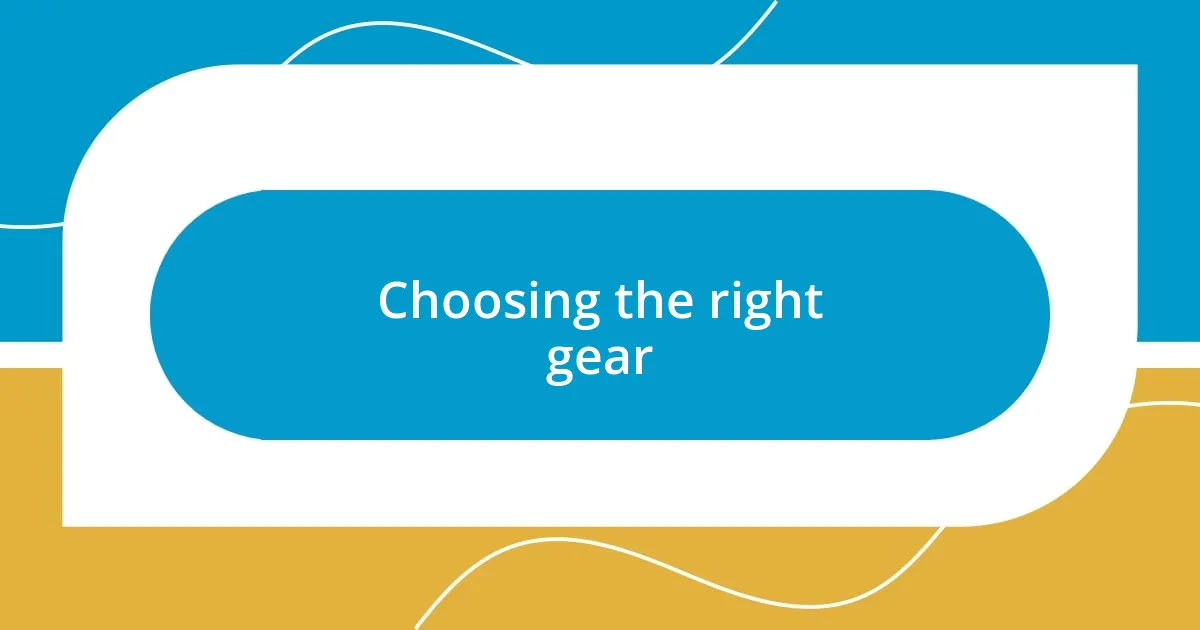
Choosing the right gear
Choosing the right gear is pivotal for any successful shoot. I always start by assessing the type of project I’m working on. For instance, if I’m filming an action sequence, I might opt for a lightweight camera rig and gimbals to ensure smooth movement. When I filmed a chase scene through a crowded street, the right gear allowed for fluid shots that captured the adrenaline of the moment perfectly.
I also think about versatility. It’s handy to have a multi-purpose lens that can adapt to various situations. I once used a 24-70mm lens during a documentary shoot, which transformed from tight close-ups to wide landscapes effortlessly. That adaptability not only saved me time but also kept the story flowing. Have you ever felt that the right choice of lens completely changed the narrative?
Lastly, don’t overlook the importance of backup gear. In the past, I faced a situation where my primary microphone failed during an interview. Thankfully, I had a backup that saved the day. It’s crucial to ensure that you’re always prepared for the unexpected surprises that can arise.
| Gear Type | Use Case |
|---|---|
| Lightweight Camera Rig | Action Scenes |
| Multi-Purpose Lens | Versatile Shooting Conditions |
| Backup Microphone | Interviews & On-location Sounds |
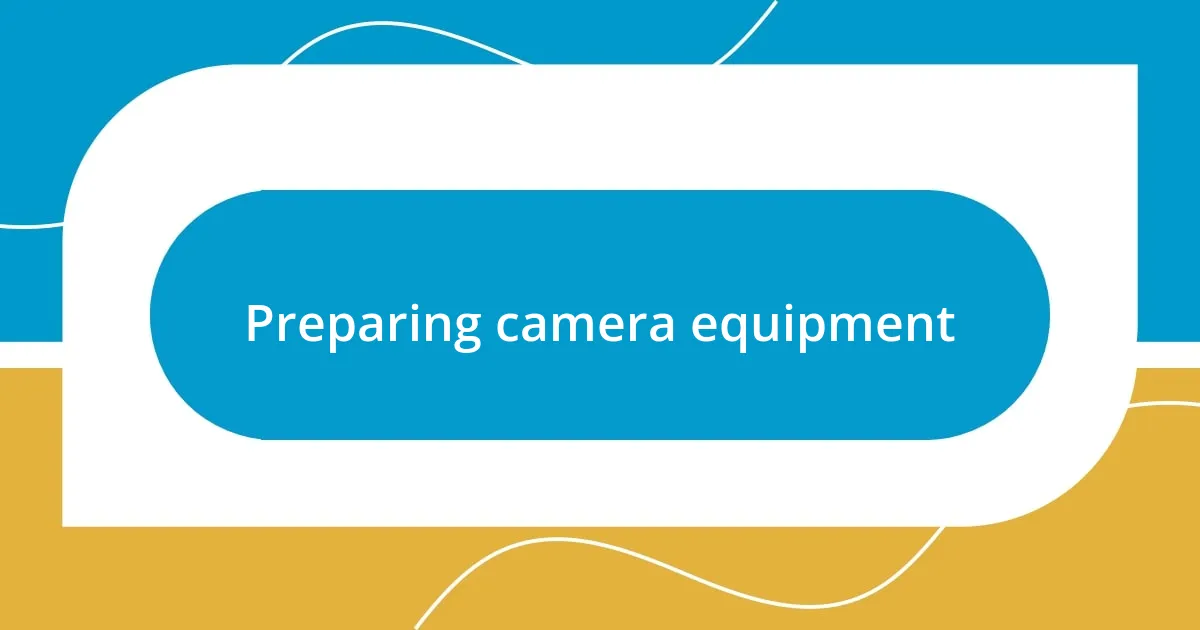
Preparing camera equipment
When I prepare my camera equipment, I find it’s crucial to have a checklist. One time, I dashed to a shoot only to realize I left my extra battery behind. The panic that washed over me reminded me of the importance of being thorough. Now, I make sure to double-check everything before I leave home.
Here’s a quick list of what I typically include in my camera prep:
- Camera body and lenses
- Extra batteries and charger
- Memory cards with ample storage
- Tripod or stabilizer for steady shots
- Lighting equipment, if needed
- Lens cleaning kit to ensure clear shots
Having everything organized not only saves time but also keeps my mind at ease. The last thing I want is to be scrambling to find a lens cap or a memory card in the middle of a shoot, giving me a sense of calm as I dive into the creative process.
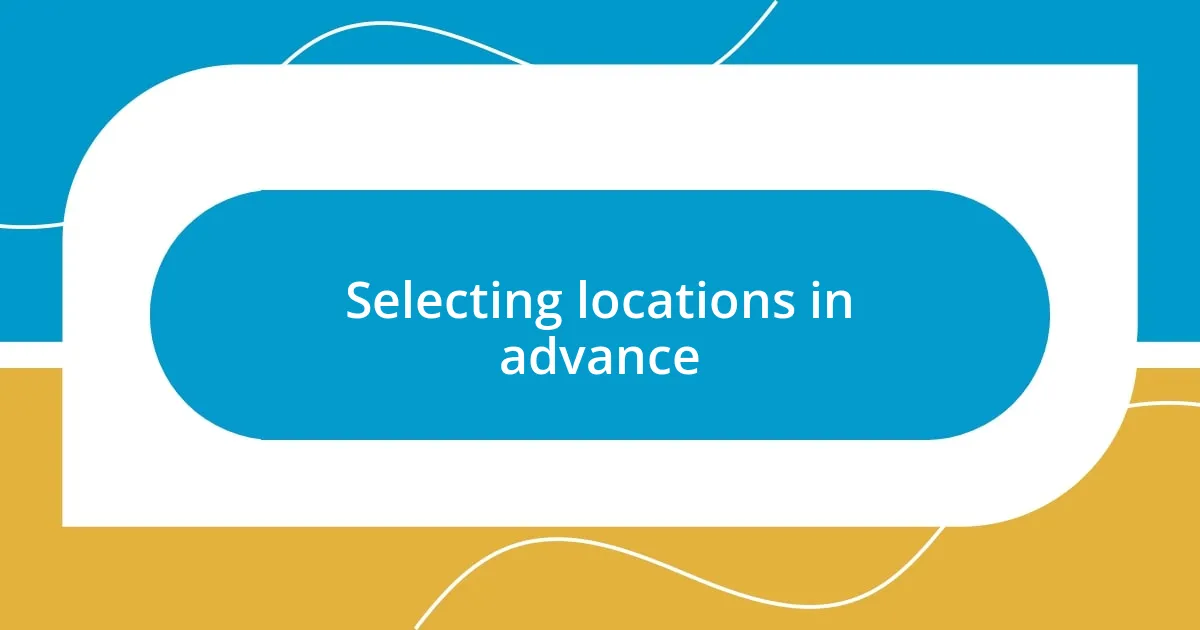
Selecting locations in advance
Selecting the right locations in advance can make or break a shoot. I remember a project where I opted for a secluded forest location to capture a serene atmosphere. However, upon arriving, I discovered that a music festival was happening nearby, transforming the tranquility into a cacophony of noise. Planning my locations in advance helps me avoid such unpleasant surprises. Have you ever arrived at a location only to find it unsuitable? It’s a frustrating experience that can be easily mitigated with a bit of foresight.
Doing thorough research ahead of time not only saves me from unforeseen disturbances but also helps in visualizing the shots I want to achieve. I often use tools like Google Earth or location scouting apps to gather insights about lighting and landscape. For instance, I once spotted a breathtaking cliff while viewing a location online; when I arrived, it was every bit as stunning as I hoped. Knowing the specific features of a location lets me plan my angles and camera settings better, ultimately enhancing the quality of the final product.
Visiting locations before the shoot day is another practice I swear by. It allows me to feel the space and even test out lighting at different times of day. On one occasion, I arrived early to a beach location and found the perfect spot just as the sun was setting, casting a golden hue that added a magical touch to the scene. This kind of preparation creates a deeper connection to the work and opens the door for creative ideas that might not have surfaced otherwise. How do you scout your locations? That initial exploration can be where the magic really happens.
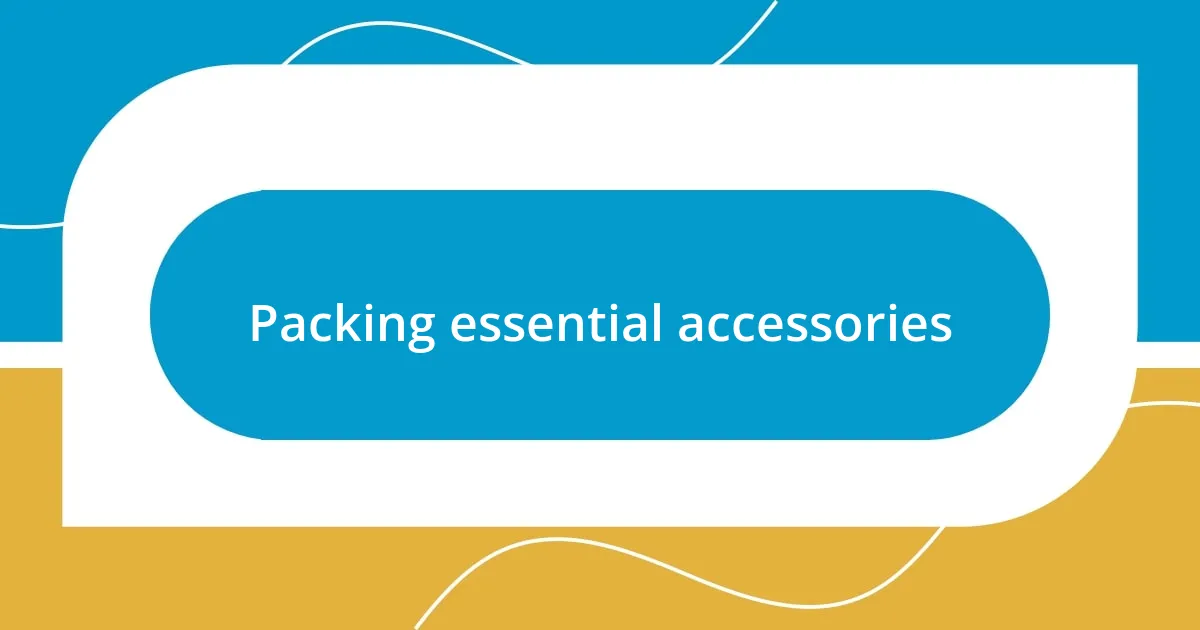
Packing essential accessories
When it comes to packing essential accessories, I always focus on the small items that can easily slip my mind. One day, I found myself on a shoot without my favorite remote shutter release, which really hindered my ability to capture those perfectly timed shots. Now, I make it a point to have a dedicated pouch where I keep all the small but crucial accessories like my remote, extra lens caps, and backup cables. Do you have a go-to spot for your essentials?
I’ve also learned the hard way about the importance of outdoor gear. During a particularly chilly outdoor shoot, I realized I didn’t pack extra gloves or hand warmers. It’s incredible how cold fingers can disrupt your focus and creativity! Nowadays, I include items like a sturdy rain cover for my camera and a comfortable jacket to ensure I’m ready for the elements. Packing wisely allows me to concentrate on the artistry rather than being distracted by discomfort.
Another aspect I always emphasize is having a well-thought-out organization system. I categorize my accessories in my bag so that I can quickly find what I need without rummaging through everything. For example, I use waterproof pouches for my memory cards and a sealed case for my lens filters. This not only makes it easier to grab what I need but also protects my gear from unexpected weather changes. Have you ever had a moment where disorganization cost you a great shot? Trust me, a little preparation can save a lot of frustration on the day of the shoot.
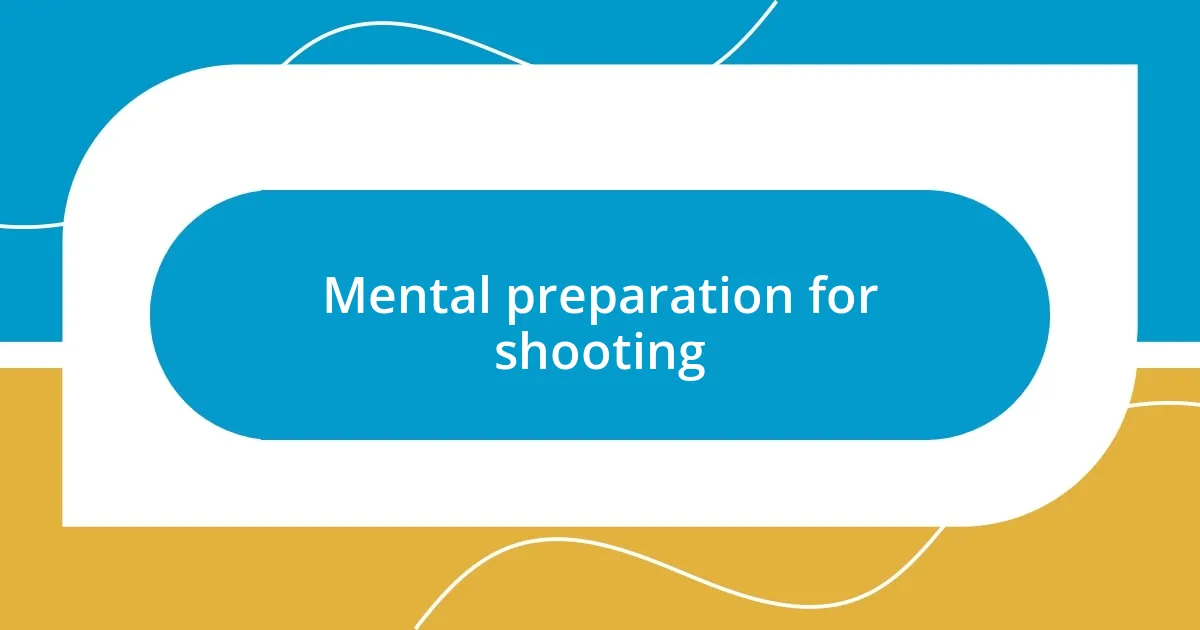
Mental preparation for shooting
Mental preparation is a crucial part of my shooting day. I’ve found that a clear mindset can significantly impact my creativity and focus. One encounter sticks with me: I was about to shoot a client’s portrait in a bustling city park but felt anxious due to a chaotic morning. Taking a few moments to breathe deeply and visualize the shoot helped ground me. Have you ever found that your surroundings can distract your creative flow? It’s essential to set a mental stage for the work ahead.
To enhance my mental readiness, I often meditate or engage in light stretching before I head out. These practices help clear my head and open my mind to new ideas. I recall a day when an unexpected rainstorm forced me to adapt quickly. Instead of panicking, my centered state allowed me to embrace the moment, leading to some stunning moody shots that I hadn’t planned for. How do you prepare mentally for such surprises in your work?
I also rely on positive affirmations to bolster my confidence. A few motivating phrases written down can serve as a reminder of my skills and what I aim to achieve. There have been times when doubt crept in before a big shoot—what if the lighting isn’t right, or the subject isn’t comfortable? But reminding myself of past successes helps me push through those moments of uncertainty. Have you ever felt a wave of doubt before a shoot? It’s a common feeling, but with mental preparation, the creative process becomes something I excitedly step into rather than dread.
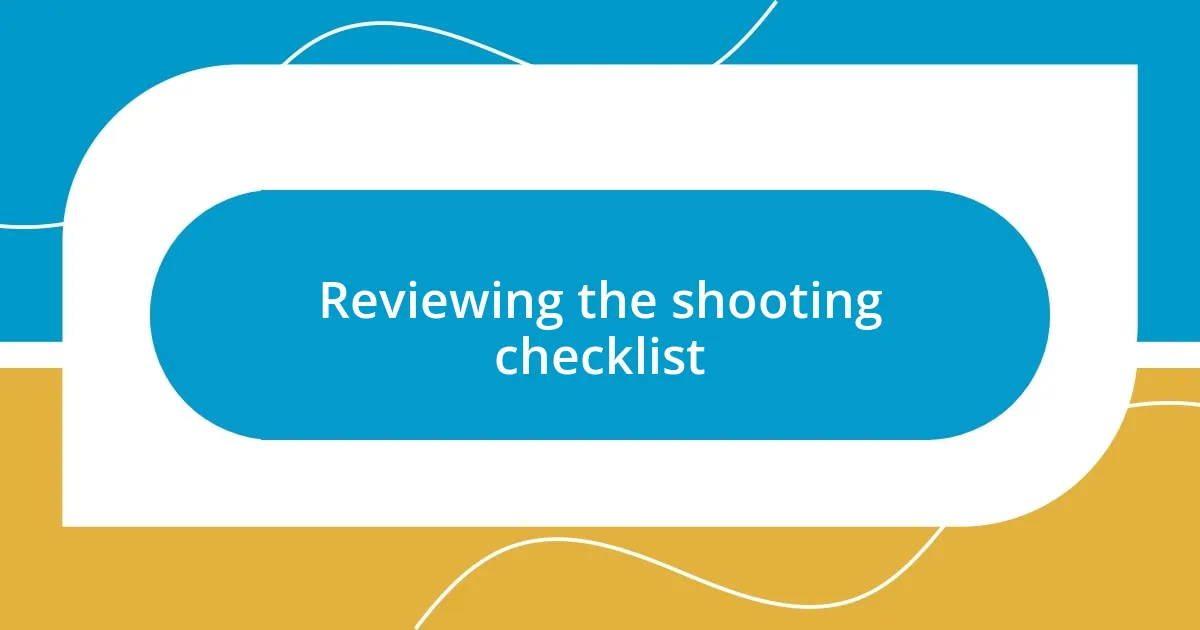
Reviewing the shooting checklist
I always find it crucial to begin my shooting day by reviewing my shooting checklist. Nothing dampens my enthusiasm more than realizing I’ve forgotten an essential piece of equipment once I’m at the location. Just last month, I rushed out the door excited for a sunrise shoot, only to find I’d left my tripod behind. Since then, I’ve established a habit of going through my checklist the night before, ensuring everything is in order and ready to go.
As I review my checklist, I pay special attention to details I might overlook in the chaos of packing. I recall one instance where I was so focused on my camera settings that I neglected to double-check my memory card—thankfully, I caught it at the last minute. This is when I remind myself that each item on that list has its purpose and importance. Is there a specific item you tend to overlook? For me, it’s often the little things, like spare batteries or lens wipes, that can make a significant difference during a shoot.
Finally, I believe actively checking off items as I pack instills a sense of preparedness and confidence. The process itself becomes a form of mental rehearsal. I can picture each element in use, which helps alleviate pre-shoot anxiety. Have you thought about how that simple checklist can reduce stress? It’s a surprisingly effective way to ensure that I can focus solely on my creative vision when I arrive on site—because when you’re in the moment, the last thing you want is to be distracted by logistical oversights.












